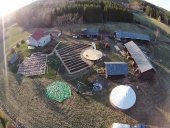



Jay C. White Cloud wrote: I would also point out that most vernacular architecture built on "freezing ground" or permafrost is facilitated "on top," in some form of "rafting modality," and not into the frozen ground...if that was your main point...we are in complete agreement as trying to build "below grade" in these condition (though very doable) is often not the easiest, nor the most ergonomic logistically or tangibly.

Jay C. White Cloud wrote:Hello Niklas, et al,
You do not have to dig a foundation into the ground...
This is more an "architectural habit" and/or social building normative culture than a "design mandate." Most architecture in the world either "sites" on its building site and then the next most common type is "post in ground," or a combination of the two forms. The concept of "frost heave" is also a misnomer very often. The soils types have as much (probably more) to do with "heaving" than the "freezing process." Bentonite clays, for example, expand with way more force than freezing water can and this effect can take place in summer or winter. Ice does expand, yet it must have something to expand with...ergo...no accumulated water....no "frost heave."
So what ever system you employ...have good drainage designed into the system, and know/understand you soil types.
Regards,
j


